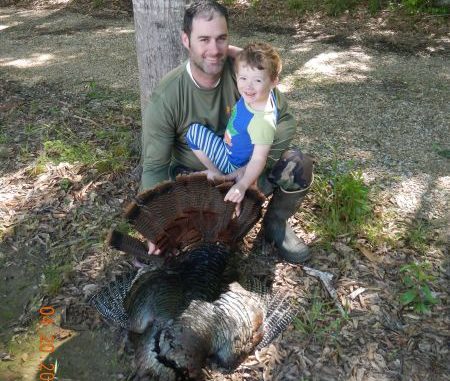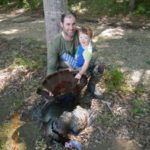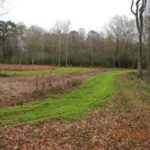
Habitat work shouldn’t stop over the summer
An e-mail from Jimmy Stafford, turkey biologist for LDWF, indicated a poor 2013 spring turkey season across the state, with the harvest being down 500 or more turkeys from the 2012 season.
The turkey talk that I heard echoed his statement that turkey hunting was poor; many hunters commented that the toms always seemed to be with hens. Perhaps the weather that gave us a warm and uneventful deer season is also to blame for a mediocre turkey season.
It seems like the cold weather we needed for deer hunting did not arrive until spring.
From my perspective, I had a great turkey season — one of the best ever. I killed my two toms the first week of the season on our small property in East Feliciana Parish, and on the last Saturday of the season called up the elusive Clear-Cut Tom that my son-in-law Dave Guidry bagged.
This was the third season to hunt this gobbler, and it has been quite challenging — but finally it all came together for the hunters.
Patience was the key to my hunting success this past spring. While many turkey hunters like to run-and-gun, on small properties this is not possible, so it becomes a waiting game; wait for them to show up, and then try to lure them in for the shot.
The real key to my hunting success started several years ago when I began making a concerted effort to keep the properties I hunt attractive for turkeys.
Turkeys respond well to management work; if you leave the fields and woods after the turkey season and don’t show back up until next August when you start thinking about deer hunting and it’s time to sow some seed, you have just fouled out.
This game fowl needs help; fields that are left to grow up in thick grass do little to help a hen successfully raise a brood of young turkeys. And when it comes to turkey hunting, it is all about having turkeys to hunt. If there are no turkeys, trust me, the hunting is going to be slow — very slow.
Turkeys respond to plantings, both fall and winter, and they respond well to just general farm work, bush-hogging and fallow disking of native ground.
The three adult toms that the Moreland/Guidry Clan bagged had clover leaves in their craw. The clover came from winter plantings.
My winter seed mixes always have clover; this past season I mixed crimson clover, white ladino clover, arrowleaf and red clover with wheat and oats. In addition to these two grasses, I also have both Timothy grass and rye grass that regenerate every year on-site.
These plantings are done in strips in between strips and patches that are planted in the spring and summer. Spring plantings consist of millet, sorghum and sunflowers. These plantings will be left to seed- out and stand during the fall and winter to provide food and cover for the turkeys.
This spring I am also planting some strips of native seed, various grasses, composite flowers and partridge pea. In addition to these plantings, I manage strips and patches containing other native grass and flowers that provide seed for the birds.
Periodic bush-hogging provides turkeys with various heights of vegetation, which attracts various species of insects. Insects are the main food item of newly hatched turkeys, and it is of the utmost importance to provide foraging areas for the young poults. If the ground vegetation is too thick, the young turkeys cannot move around and find food.
Spring and summer strips will be plowed up in late winter to provide feeding sites for the turkeys in late winter and early spring. Fresh-plowed ground attracts turkeys and works well during the hunting season, keeping one from having to rely on the yellow gold, which I do not recommend at all.
Now is also the time to be sure the habitat is productive for the deer. From the standpoint of bucks, it is the time that they are growing both their body and their new set of antlers. So now is the time to be sure the habitat is providing the nutrition they need to achieve the desired growth and development so they can reach their potential.
Adult does are pregnant and also need good nutrition to ensure a successful pregnancy, as well as do some growing of their own.
Winter plantings with the clover mix provide good protein for them; crimson clover will produce seed first and disappear from the field as the temperatures rise. White clover and arrowleaf clover will hold on longer and, if soil moisture is adequate, will continue to provide nutritional forage through the early summer months.
Spring is when native browse is at its best, and logging done this past fall and winter will begin producing new browse during the summer.
One of the best equipment investments I made was purchasing a Stihl heavy-duty, gas-powered pruner. This tool has become as important as my chain saws.
Privet is a common shrub in the Clinton area and is a good deer browse, but it grows fast and can get out of reach of the deer in a growing season. The pruner keeps the privet under control along the edges of fields and rights-of-way.
We have created feeding hedges of privet and American beauty berry, and the pruner is used to keep the forage available to the deer.
A quick walk around the grounds at Camp David will show the browsing that is being done by the deer.
The cost for this item was as much as a chain saw, but it has been worth the investment. My friend McElroy and I even used it to cut bull rushes growing in the lake along the 18th fairway at the recent Zurich Open course in NOLA. The golf pros had full view of the ball from tee box to green on this par-five hole.
Spring plantings for deer will consist of American jointvetch, and peas and beans. Deer will also be eating the forage produced in the spring turkey plantings, as well as the seed heads of the sorghum in the fall.
One of the problems associated with these plantings is, of course, hogs. They have already been rooting up the corn that was planted in early April. Two of them have paid the price for their role in this activity, and plans are in the works to remove a few more.
Now is the time to keep going with your hog control program. With turkey season over, feeders can be filled and can be used to attract the porkers. Set the cameras up, along with some sort of night light, and the hunting season continues.
While the past deer season was not real spectacular, there were some good deer killed, and you can see the scores of many of them on the LDWF Web site. Some of you saw a number of these great deer at the Louisiana Sportsman Show in Gonzales and the Bowie Outfitters Big Buck Contest in Baton Rouge.
Several youth hunters did quite well this past season. Kendall Haygood of West Monroe killed a 181 5/8-inch non-typical buck, Meghan Odom of St. Francisville made a 104 2/8-inch typical bow kill on a velvet buck, Trenton Lemoine of New Roads smacked a 142 5/8-inch typical deer, and Raymond Liotta of St. Amant arrowed a 145-inch typical buck while hunting in Kansas.
Congrats to these youth hunters; they are the future of our sport.
A few years back I predicted a new state typical record from Avoyelles Parish. Well, Travis Lucas of Hessmer bagged a 175 6/8-inch typical buck with his crossbow hunting on public land in Avoyelles Parish. I still think we will see a new typical state record from this parish at some point in the future.
So if you are looking at having success in the 2013-14 turkey and deer seasons, now is the time to start doing the work that will help make it happen. Who knows, perhaps you might be the one that kills that trophy buck or turkey that we will be writing about next year.




